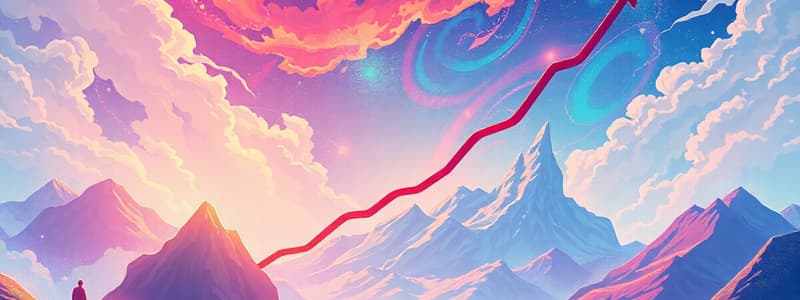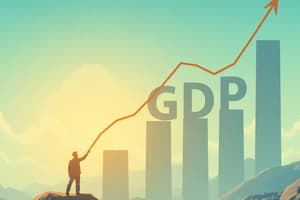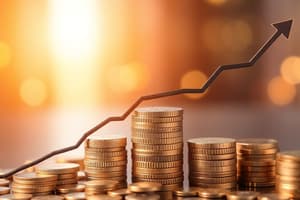Podcast
Questions and Answers
Which of the following scenarios would be included when calculating a country's GDP?
Which of the following scenarios would be included when calculating a country's GDP?
- The services provided by a cleaning company. (correct)
- The purchase of raw materials by a manufacturing plant.
- The sale of a used car manufactured in another country.
- The value of stocks traded on the stock market.
Which of the following is the most accurate description of 'full employment'?
Which of the following is the most accurate description of 'full employment'?
- A situation where only frictional and structural unemployment exist. (correct)
- A situation where there is absolutely no unemployment in the economy.
- A situation where cyclical unemployment is eliminated.
- A situation where the unemployment rate is at 0%.
Nominal GDP provides a more accurate representation of economic growth than Real GDP when comparing economic output across different years.
Nominal GDP provides a more accurate representation of economic growth than Real GDP when comparing economic output across different years.
False (B)
The unemployment rate includes discouraged workers who have stopped looking for a job.
The unemployment rate includes discouraged workers who have stopped looking for a job.
What are the three primary economic goals that policymakers typically aim to achieve?
What are the three primary economic goals that policymakers typically aim to achieve?
A recession is technically defined as _____ successive quarters of decreasing Real GDP.
A recession is technically defined as _____ successive quarters of decreasing Real GDP.
What are the three main types of unemployment?
What are the three main types of unemployment?
The percentage change in the price of a market basket of goods and services over time is known as the ______ rate.
The percentage change in the price of a market basket of goods and services over time is known as the ______ rate.
Why is economics not considered a traditional science like physics or chemistry?
Why is economics not considered a traditional science like physics or chemistry?
Match the following economic measurements with their definitions:
Match the following economic measurements with their definitions:
Match the following economic phases with their corresponding characteristics:
Match the following economic phases with their corresponding characteristics:
What is the primary risk associated with deflation?
What is the primary risk associated with deflation?
Which of the following transactions is most likely to be excluded from a country's GDP calculation?
Which of the following transactions is most likely to be excluded from a country's GDP calculation?
Macroeconomics primarily focuses on the behavior of individual consumers and firms rather than the entire economy.
Macroeconomics primarily focuses on the behavior of individual consumers and firms rather than the entire economy.
GDP provides a complete picture of a country's economy.
GDP provides a complete picture of a country's economy.
Which component of GDP is often the largest?
Which component of GDP is often the largest?
What is cyclical unemployment?
What is cyclical unemployment?
When significant spending increases GDP, unemployment falls, and factories produce at full capacity, an economy is experiencing a(n) ______.
When significant spending increases GDP, unemployment falls, and factories produce at full capacity, an economy is experiencing a(n) ______.
Flashcards
Macroeconomics
Macroeconomics
The study of the economy as a whole, focusing on broad issues.
Key Economic Goals
Key Economic Goals
Economic growth, limited unemployment and stable prices.
Gross Domestic Product (GDP)
Gross Domestic Product (GDP)
The total value of all final goods and services produced within a country's borders in a specific time period.
Used goods and GDP
Used goods and GDP
Signup and view all the flashcards
Nominal GDP
Nominal GDP
Signup and view all the flashcards
Real GDP
Real GDP
Signup and view all the flashcards
Recession
Recession
Signup and view all the flashcards
Depression
Depression
Signup and view all the flashcards
Unemployment Rate
Unemployment Rate
Signup and view all the flashcards
Discouraged Workers
Discouraged Workers
Signup and view all the flashcards
Underemployed
Underemployed
Signup and view all the flashcards
Frictional Unemployment
Frictional Unemployment
Signup and view all the flashcards
Structural Unemployment
Structural Unemployment
Signup and view all the flashcards
Cyclical Unemployment
Cyclical Unemployment
Signup and view all the flashcards
Full Employment
Full Employment
Signup and view all the flashcards
Inflation Rate
Inflation Rate
Signup and view all the flashcards
Business Cycle
Business Cycle
Signup and view all the flashcards
Study Notes
Introduction to Macroeconomics
- Macroeconomics studies the entire economy, focusing on broad issues.
- Key areas of focus include economic output, unemployment, inflation, interest rates, and government policies.
- Macroeconomics emerged as a distinct field in response to the Great Depression of the 1930s.
- Comprehensive data on economic activity was lacking prior to the Great Depression.
- Even with abundant data, economists may disagree on the economy's condition, future, and appropriate policies.
- Predictions rely on data, models, and trends but are subjective.
- Economics differs from traditional sciences, as controlling variables is hard because people may be unpredictable.
Key Economic Goals and Measurements
- Policymakers target economic growth, limited joblessness, and stable prices.
- Achieving these goals tends to increase citizen satisfaction, political success, and potentially economists' salaries.
- Economists use GDP, unemployment rate, and inflation rate to gauge economic progress.
Gross Domestic Product (GDP)
- GDP represents the monetary value of all final goods and services produced within a country's borders during a specific period.
- GDP excludes certain transactions, such as the sale of used goods.
- Specifically, GDP does not include used domestic goods, financial assets, or corporate acquisitions.
- Illegal and non-traditional economic activities are excluded from GDP measurements.
- GDP is measured in dollars.
- Nominal GDP is not adjusted for inflation.
- Real GDP is nominal GDP adjusted for inflation, providing a more accurate measure of economic health.
- In 2013, Greece's Real GDP was approximately $242 billion.
- Greece experienced six years of declining GDP from 2008, leading to a severe recession.
- A recession is defined as two consecutive quarters of declining Real GDP.
- Greece's GDP saw a slight increase in 2014, signaling the end of its recession.
- A depression is essentially a very severe recession and lacks a precise definition.
- GDP calculation methods vary between countries.
- Some EU nations have considered including underground markets in GDP calculations.
- GDP may not fully represent a country's economy but is the primary measurement available.
- GDP was developed to account for national income.
- Economic decisions during the Great Depression were based on limited data like stock price indices.
Unemployment Rate
- Unemployment policy aims to limit unemployment.
- The unemployment rate is the key metric.
- Greece's unemployment rate exceeded 25%.
- The unemployment rate is calculated as (number of unemployed/labor force) * 100.
- The labor force includes those of legal working age who are either employed or actively seeking work.
- Discouraged workers who stop looking for work are excluded from the labor force and unemployment statistics.
- The underemployed, who hold part-time jobs but desire full-time work, are also not reflected in the rate.
- Zero unemployment is not a realistic or desirable goal due to the existence of frictional and structural unemployment.
- Frictional, structural, and cyclical unemployment are the three types.
- Frictional unemployment is temporary unemployment, such as people between jobs.
- Structural unemployment arises from a mismatch between the skills workers have and the skills employers need.
- Cyclical unemployment results from economic downturns.
- Full employment refers to a situation where only frictional and structural unemployment exist.
- The natural rate of unemployment varies; in the U.S. it typically ranges from 4-6%.
- GDP growth and unemployment have an inverse relationship.
- The inverse relationship was observed during the Great Depression.
Inflation Rate
- The goal is price stability, avoiding rapid inflation or deflation.
- Greece recently saw prices fall by about 2%.
- The U.S. experienced a negative 10% inflation rate during the 1930s.
- Inflation is measured by tracking the prices of a market basket of goods and services.
- The inflation rate is the percentage change in the price of the basket over time.
- High inflation reduces purchasing power and has negative economic consequences.
- Inflation increases business costs through higher wages and interest rates.
- Deflation discourages spending.
- Decreased spending can lower GDP and raise unemployment.
- Severe recessions often involve deflation.
- Prices often increase as the economy recovers.
The Business Cycle
- Economies expand and contract over time - these fluctuations are known as the business cycle.
- GDP, employment, and inflation indicate the economy's phase.
- An expansion involves increased spending, rising GDP, falling unemployment, factories producing at capacity, and potential inflation.
- A contraction involves an economic slowdown, business layoffs, reduced consumer spending, and further layoffs.
- The business cycle describes recurring booms and busts.
- GDP is comprised of consumer spending, business investment, government spending, and net exports.
- Consumer spending is generally the largest component of GDP.
- Changes in GDP components impact the economy's speed.
- Some economists advocate for government intervention to manage the economy.
- Governments can increase spending or cut taxes to combat recessions, potentially increasing debt.
Studying That Suits You
Use AI to generate personalized quizzes and flashcards to suit your learning preferences.




